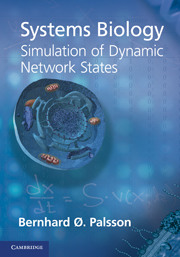APPENDIX B - Homework problems
Published online by Cambridge University Press: 05 August 2012
Summary
Introduction
1 Read Part 1 of [89] to familiarize yourself with the process of reconstructing biochemical reaction networks. These are the networks whose dynamic states we want to study.
2 Read Chapters 6, 9, and 10 in [89] to familiarize yourself with the stoichiometric matrix and its null spaces.
3 Take a couple of hours to browse the websites in Table 1.1
Basic concepts
1 Derive Eqs (2.14), (2.15), and (2.16).
2 For a reaction that has a net flux of 1, display graphically how Γ → Keq as the forward reaction rate increases from 1 to 1000.
3 Derive the net reaction for
using mass action kinetics. Show the rate expression when (1 - Γ/Keq) is considered as a factor in the equation.
4 Formulate the details of
for three cofactors in Table 8.1, including CoA.
Dynamic simulation: the basic procedure
1 Let us consider that a chemical system is described by the concentration of 10 variables denoted by x1, x2, …, x10.
(i) By assigning numerical random values between 0 and 1 to the 10 variables, construct a hypothetical time series comprised of 100 measurements at different times.
(ii) Verify that in this case the time correlation matrix R, defined in Eq. (3.7), shows no correlation.
Information
- Type
- Chapter
- Information
- Systems Biology: Simulation of Dynamic Network States , pp. 288 - 305Publisher: Cambridge University PressPrint publication year: 2011
